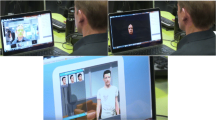Abstract
This study investigates the effects of performance and communication within audio-visual (shared representations) and audio-only conditions. Two three-dimensional (3D) representations were presented in each communication condition. The goal of the study was to examine both explicit and implicit references made during verbal interactions, and to gather subjective usability evaluations of each representation. Sixty dyads performed a series of problem solving tasks in three experimental conditions: mixed, 3D cylinder and 3D helix representations. Assessment measures included overall performance time and accuracy, and user attitudes pertaining to the usability of the displays. Although no differences in task performance were observed, qualitative measures revealed differences between representation and communication groups. User preferences for 3D cylinder and 3D helix representations were observed, with disparate strategies being adopted between groups. In general, the analyses indicated that the presence of shared visual information enhances collaborative problem solving.








Similar content being viewed by others
References
Ainsworth SE, Peevers GJ (2003) The interaction between informational and computational properties on problem-solving and learning. In: Proceedings of the 25th annual conference of the Cognitive Science Society, Boston, Massachusetts, July/August 2003
Chapanis A (1975). Interactive human communication. Sci Am 232:3–42
Chou C, Tsai C-C, Tsai H-F (2001) Developing a networked VRML learning system for health science education in Taiwan. Int J Educ Dev 21:293–303
Doherty-Sneddon G, O’Malley C, Garrod S, Anderson A, Langton S, Bruce V (1997) Face-to-face and video-mediated communication: A comparison of dialogue structure and task performance. J Exp Psychol Appl 3(2):105–125
Hicks M, O’Malley C, Nichols S, Anderson B (2003) Comparison of 2D and 3D representations for visualising telecommunications usage. Behav Inform Technol 22(3):185–201
Hutchins E (1995) Cognition in the wild. MIT Press, Cambridge
Kotovsky K, Simon HA (1990) What makes some problems really hard: Explorations in the problem space difficulty. Cognitive Psychol 22:143–183
Larkin JH, Simon HA (1987) Why a diagram is (sometimes) worth ten thousand words. Cognitive Sci 11:65–99
Meister D (1986) Human factors testing and evaluation. Elsevier, New York
Monk A, McCarthy J, Watts L, Daly-Jones O (1997) Measures of process. In: MacLeod M, Murray D (eds) Evaluation for CSCW. Springer, Berlin Heidelberg New York, pp 1–7
Neale H, Nichols S (2001) Theme-based content analysis: a flexible method for virtual environment evaluation. Int J Hum Comput St 55:167–189
Ochsman RB, Chapanis A (1974) The effects of 10 communication modes on the behaviour of teams during co-operative problem-solving. Int J Man Mach Stud 6:579–619
Okada T, Simon HA (1997) Collaborative discovery in a scientific domain. Cognitive Sci 21(2):109–146
Perkins DN (1993) Person-plus: A distributed view of think and learning. In: Salomon G (ed) Distributed cognition: Psychological and educational considerations. Cambridge University Press, Cambridge , pp 88–111
Salomon G (1993) No distribution without individuals’ cognition: A dynamic interactional view. In: Salomon G (ed) Distributed cognition: Psychological and educational considerations. Cambridge University Press, Cambridge, pp 111–138
Zhang J (1997) The nature of external representations in problem solving. Cognitive Sci 21(2):179–217
Zhang J (1998) A distributed representation approach to group problem solving. J Am Soc Inform Sci 49(9):801–809
Acknowledgements
This work was supported by a research studentship funded by University of Nottingham and BT.
Author information
Authors and Affiliations
Corresponding author
Rights and permissions
About this article
Cite this article
Hicks, M., Nichols, S. & O’Malley, C. Comparing the roles of 3D representations in audio and audio-visual collaborations. Virtual Reality 7, 148–163 (2004). https://doi.org/10.1007/s10055-004-0126-0
Received:
Accepted:
Published:
Issue Date:
DOI: https://doi.org/10.1007/s10055-004-0126-0




